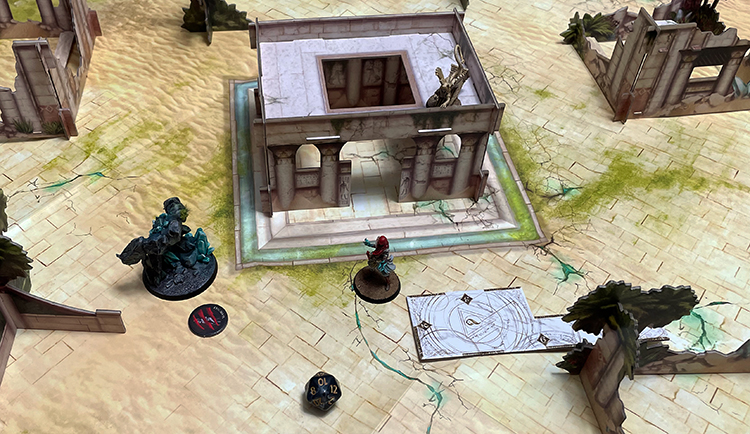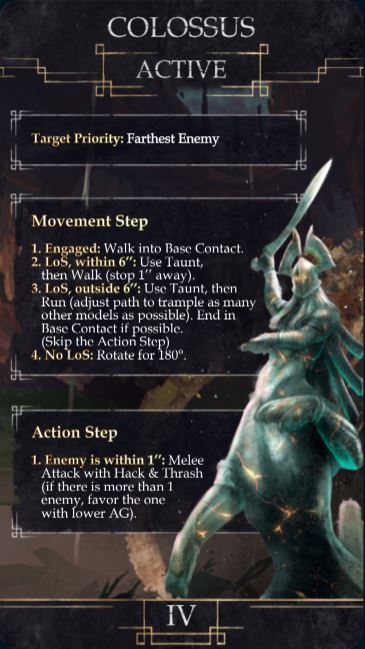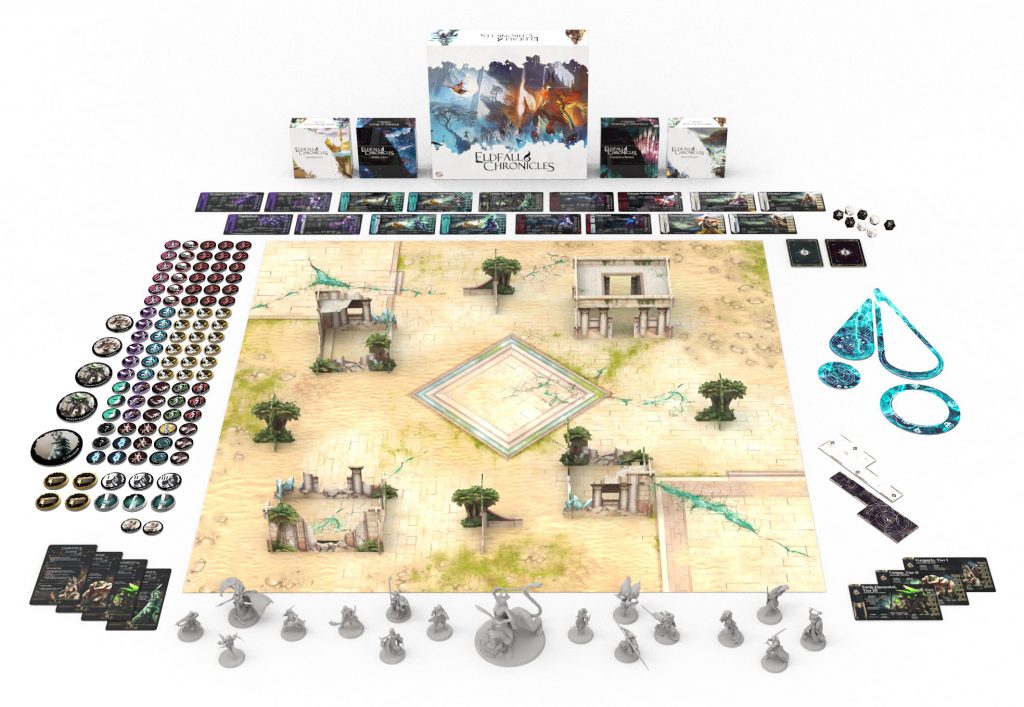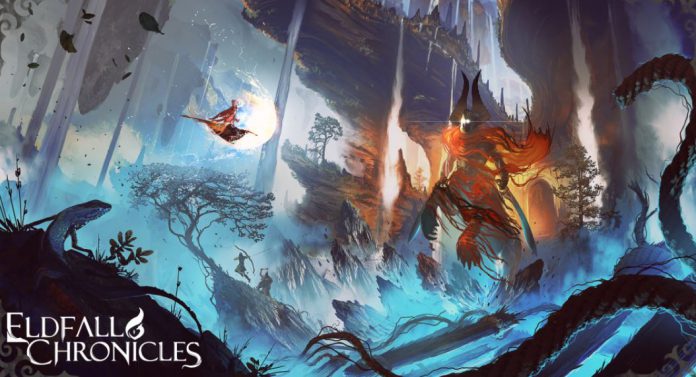There are a lot of tabletop miniature games out there. Be it historical, fantasy, science fiction, or a blend of two or more, there’s a lot to choose from and depending on your time and budget it can be important to know which games will click with you. Here we are taking a look at Eldfall Chronicles, a fantasy tabletop skirmish game that boasts a number of different play modes and some very slick rules and models. But does it hold up? Is it worth it? Read on.
What is Eldfall Chronicles?
Eldfall Chronicles is a relatively new entry into the skirmish-level games and pits one or more players and their elite force against the dangers of the world (and beyond) or against one another. As with most skirmish games, each individual model is given a good deal of attention and everyone has a critical role to play. We’ll detail a bit of that as we delve into the game, as both gameplay and hobby aspects are intricate and rewarding if you stick with it.
The game developer, Freecompany, (appropriately) provides the games rules, model stats, tutorial videos, and other content for free on its website, which allows potential players to comfortably review the game for themselves upfront before making any commitments. There are multiple levels which players can buy into, be it just picking up a single faction box, to the core boxset, or beyond. This review is primarily focused on the core rules and gameplay, but other articles will specifically showcase the different factions, models, and other aspects.
It’s not very often a game provides both player-versus-environment (PVE) and player-versus-player (PVP) within the same system, but Eldfall Chronicles manages to walk that line and as you’ll read below leaves us with a robust game system for players to enjoy.
The world and its people
Eldfall Chronicles is set in the world of Calad, many years since a series of cataclysmic incursions from beyond the known world brought the ancient creators and guardians known as Elders of Calad low, leaving all dead or vanished. Over time the native populations and the invading forces struggled for control of available lands and resources, ending with the primary invasion force being fought back to where they entered the world and sealed off. In the aftermath, some groups joined forces to better defend and expand their territory, while mercenaries sought profit and fight for anyone willing to part with their coin.
At the time we as players enter Calad most territory has been divvied up into four primary factions: the Coalition of Thenion, the Empire of Soga, the Helian League, and the Sand Kingdoms. Each of these factions host a variety of skilled fighters who are out to seek glory and power while also aiding their side in the continuing conflict. It makes sense that these factions would have cohesive themes, but I did find the choices of factions to be a bit derivative and stereotyped. There’s a bit of lore to flesh these out but at the end of the day your faction choices are essentially Japanese fantasy warriors, Middle Eastern mystics with flying carpets, mixed armored military, and Dark Elves. Understandably it is difficult to come up with truly unique factions considering the literally thousands of other fantasy worlds created by now, but it does stand out as one of the weaker design choices.
Coalition of Thenion
 The Coalition of Thenion is a bit of an oddball faction in that they don’t hold a traditional territory, they instead live in subterranean cities protected by shadowy guilds. Dwelling in the dark, the Coalition are experts of stealth, assassination, and subterfuge. As you might imagine, these rogue-like characters are a bit of a glass cannon and live or die by playing to the terrain and situation properly. If they go undetected they are incredibly deadly, but caught in the open they are incredibly dead.
The Coalition of Thenion is a bit of an oddball faction in that they don’t hold a traditional territory, they instead live in subterranean cities protected by shadowy guilds. Dwelling in the dark, the Coalition are experts of stealth, assassination, and subterfuge. As you might imagine, these rogue-like characters are a bit of a glass cannon and live or die by playing to the terrain and situation properly. If they go undetected they are incredibly deadly, but caught in the open they are incredibly dead.
The Empire of Soga

The largest faction in terms of territorial size, the Empire of Soga is a sprawling wintry location divided by feudal lords and hosting a variety of viscous spirits and demons. Drawing directly from Japanese culture, its fighters are primarily swordspeople, with an archer for covering fire and a fox-spirit spellcaster tagging along for good fiery measure. Like the Coalition these are powerful at close range, but they offer a much better defensive profile and boast the most HP out of any faction. Something tactically interesting is that most of its models are of the Warrior class, which allows them to be a potent threat even in the Reactive role. They are the powerhouse “clean fight” faction, using incredible skill and strength to eliminate the enemy through direct battle.
The Helian League

A proud and harmonious people, the Helian league organized and lead the battle to save Calad from the invading forces. Clad in shining armor, these people of the sun are the balanced faction, including a melee threat, defensive guard, offensive spell-caster, and divine mage. This is a faction that works best when it works together and makes good use of the Soldier class to strengthen themselves when in close proximity. As this is a small model-count skirmish game, however, if the Helians get picked apart by distance or deaths they can start to see things crumble.
The Sand Kingdoms
 The citizens of the Sand Kingdoms are people of culture, knowledge, and trade. Their civilizations are built upon the ancient ruins of powerful dynasties long since vanished, but they have been able to learn a great deal of magical techniques from what treasures they have discovered. This faction consists entirely of spellcasters and hosts a number of powerful direct-damage attacks, enchantments, as is the only wielder (currently) of summoning magic. This ability is powerful, as it allows Sand Kingdoms parties to produce powerful/disposable allies to harry the enemy without exposing their real models. This is good, because the real models can be quickly dispatched if their player is not careful. This faction is definitely more difficult to learn up from due to some of their unique rules, but they can be quite dangerous in the right hands.
The citizens of the Sand Kingdoms are people of culture, knowledge, and trade. Their civilizations are built upon the ancient ruins of powerful dynasties long since vanished, but they have been able to learn a great deal of magical techniques from what treasures they have discovered. This faction consists entirely of spellcasters and hosts a number of powerful direct-damage attacks, enchantments, as is the only wielder (currently) of summoning magic. This ability is powerful, as it allows Sand Kingdoms parties to produce powerful/disposable allies to harry the enemy without exposing their real models. This is good, because the real models can be quickly dispatched if their player is not careful. This faction is definitely more difficult to learn up from due to some of their unique rules, but they can be quite dangerous in the right hands.
Neutral/Semi-Affiliated
While each faction is unique and powerful on its own, often times it can be helpful to supplement your gameplay with alternative options. Each of the factions has a model with split affiliation (marked on the model card as a coin-filled purse) that is willing to work with the others, though splashing into a mercenary does come with some costs (as from the imaginary coins you’re handing over). A faction model that joins as a mercenary cannot receive its factions upgrades, only Neutral ones. The card for one true Neutral model comes with the core set, the Amazon Gladiatrix, who is no slouch in combat. It is also possible to mix in multiple faction mercenaries to open up the option for a full Neutral force with no specific affiliation.
How does this game work?
To start the game players need to determine which game type, or quest, they are participating in. The simplest is just a direct battle, which is labeled as Quest 1: Open Hostilities. This mission simply asks to incapacitate/kill the other player and rewards with victory points based on the value of the models you’ve defeated. For beginners looking to understand the mechanics of PVP this is absolutely the best choice. Further quests bring about more complicated objectives which may or may not require the opposing models be taken out before the end of the game. These are much more tactically interesting but are best left until the players have a firm grasp on the game system and their faction models.
Next each player selects a faction they want to assign to their party and selects faction-affiliated or Neutral/Semi-Affiliated models to use. Each model has a recruitment cost and the total value of the models cannot exceed the agreed-upon point limit for the game. For beginners, Freecompany recommends playing with 60pts which is enough to bring on three models and have some points remaining for upgrades/equipment. Players need to be mindful of each models inventory capacity and make sure the upgrades purchased don’t exceed their limit, otherwise they will be over-encumbered and limited in what they can do until they drop something. Players will also need to elect one of their models as the leader, which we’ll touch on a bit more in the model rules area.
The heart of this game lies in the Active/Reactive turn system. At a glance, some people might compare Eldfall Chronicles with Corvus Belli’s Infinity. The concept of unit activations and reactions is similar, but a defining (and well-thought) difference here is how activations occur and how frequently an individual model can perform them. In this game models can be activated up to a number of times equal to their Stamina, including reacting models. For core game set, each player model has the same Stamina value of 2 which makes it pretty simple to track. Players take turns being the Active player, selecting a model to activate and perform a number of different actions. The Reactive player(s) very frequently gets a chance to react to the enemy models machinations, giving each player something to do. For players mostly familiar with the “I go, you go” style game of many other systems this can take a little bit of getting used to, but once you’ve mastered it the gameplay can be much more fluid and makes each player feel they’re making important choices at any given time.
All dice rolls are based around a d20 and are either individual or opposed checks against a models statistics plus or minus any modifiers they might have. When a player must make a check on their own, they simply have to roll under the models relevant statistic (a 1 is a critical success by default). For some opposed rolls, known as Confrontation, it gets a little trickier, as the Active/Reactive players roll off using however many dice their models call for and then have a contest for which rolls are lower than their relevant stat but HIGHER than the opposing players roll. It works in practice but it’s a tad confusing and might take players a bit before they’re quickly moving through results. Being a d20 game you can expect some of your results to be a little swingy, especially if there are significant modifiers. Multiple die rolls toward the same goal and possible re-roll of a failed result can go a long way in moderating your chances of something connecting, so be on the lookout for rules and abilities that increase your Strike (number of attack rolls) or allow you to re-roll dice results. These are not common but can be very helpful to ensure you land a solid blow.

Credit: PierreTheMime
As each model only have a limited number of actions, players may discover they need to use their models and abilities to feint or draw out the Reactive players actions so they can accomplish their objectives while the enemy is exhausted. This may be simply by making potentially threatening moves with either disposable summoned minions or more defensible models (either armored or in cover or both) but there are some models that can force a model to react against their will using Taunt and others that can shut down a Reactive model for the remainder of the turn if they fall victim to a Charm ability. There’s a lot of cool interactions to play with here and makes decision-making on who is taking an action and how both interesting and important.
One of the key moves every model is going to have available is dodge. Not only is that going potentially keep your model safe from harm, but it also allows your model the ability to move up to half its Speed value and/or enter the crouched state whether it successfully dodges or not. This action has a huge amount of value, allowing your models to either grab cover or close the distance with their attacker. If you manage to make it into engagement range with a model that’s firing arrows or magic at you, you can shut that attack option down for further activations. Make like a Soulslike game and learn to love the dodge.
Something that this game makes a point about is three modes of measurement: Assisted mode, Standard mode, and Realism mode. Each of these boil down to whether or not you can pre-measure movement, attacks, and other actions during your play. The game recommends starting in “Assisted” mode where you can measure everything and graduating up to not measuring before taking actions. Personally I’ve landed on that premeasuring everything works best; denying premeasuring simple rewards players who can eyeball distances better and can lead to some very sour gameplay moments. In a game where you have a handful of models and any mistake could cost you the entire game, opening up players to frustrating errors is not the right move. Measure your actions, full stop.
Models, their rules, and how to understand them
The fighters of Eldfall Chronicles each have a Model Profile presented on a neatly printed two-sided card. For those new to RPG-style skirmish, things may seem a bit intimidating at first. The front half of a models card contains its class(es), attributes, size, point cost, model count limit, and an optional combination of traits, combat arts, skills, spellcraft, and rare model-specific special abilities. This is a helpful quick-reference doc that allows players to roll for specific checks at a glance. The back-half of the card contains thorough explanations of its individual traits and other special rules, helpfully also including its level(s) of skills and rules for its default weapons. The only thing the card lacks is the rules for any spell-related abilities, as those rules are simply too big to fit on the card in most cases. With the exception of the Sand Kingdoms, learning the spells shouldn’t take all that long as the list of available powers is limited. Due to its overall complexity, even with quick reference cards new are likely going to be going back to the main rulebook/PDF frequently before they get the rules memorized to their satisfaction.

Credit: Freecompany D.O.O.
On a Model Profile card there are 11 attributes which correspond to traditional RPG concepts, such as Agility and Intellect. A few of these attributes are used as direct resources during gameplay; for example, Stamina determines your Activation Points and carrying capacity and Health Points are (as expected) the number of times a mode can sustain injury before it is incapacitated. Other attributes like Offense and Intellect are used for as targets for skill checks, with or without modifiers depending on the situation.
Each model is assigned a combination of either one or two Classes. Every Class imparts special rules which are largely passive bonuses, though some are once-per-turn special actions or re-rolls that players can choose to use at a given time. These Class benefits are strong, and its best to keep the models Class roles in mind when making your plans. Some of these are obvious in their purpose but some are a bit more finesse and need to be applied at the proper moment.
As discussed above, each party will have a leader chosen at the time the party is constructed. In the core box, factions have one default “leader” model which supports stratagems and its assumed you’ll be using them as your leader for your games. Stratagems are powerful automatic abilities that impact the play of the turn board-wide. These come in two flavors: Authority or Subterfuge. Authority benefits your party models, either with a direct increase to a statistic or an improvement to general abilities members of your faction might use frequently. Subterfuge affects enemy models, potentially imposing penalties or allowing your models to become more effective against them. As with a lot of choices in Eldfall Chronicles stratagem selection can make or break your turn, potentially acting as a powerful force multiplier depending on your plans. Over time having the same model be the leader might start feeling a little dry and craving more options. For a starter set this is fine, but definitely be on the lookout for more options eventually.
PVP vs PVE
Being a skirmish game, most people coming into the game blind would assume that it’s completely PVP combat. That’s a good assumption considering almost every other game out there focuses on that specifically and there is absolutely plenty of that to be had. Eldfall Chronicles also makes the effort to give single or multiple players a complete PVE, laying out a series of quests that highlight the hostile elements that inhabit the world of Calad.
PVP action using the core set is a fast and fun time. Depending on what point values you and your opponent(s) land on for creating your party, it’s satisfying to determine what models/upgrades are going to fit your playstyle and how you can combine different models and abilities to surprise your opponent with your plans. Each faction plays uniquely and including the ability to blend in semi-affiliated/Neutral models there’s a lot of variety and potential even with initial models.

The game allows players to control each hostile during both their Active turn and Reactive turn, changing their behavior based simple situational conditions. There’s not a lot of subtlety when it comes to each of these monsters and with the attributes and abilities they have they don’t really need it. Aside from the initial Tier I Gargoyle, each of these hostiles is extremely durable and deadly. At least the initial hostile rules contained in the core set follow the basic “chase down and kill” mechanic–this is fine when they’re the danger you’re trying to avoid to accomplish your real objective but a direct battle against these aren’t going to be especially interesting once players are accustomed to their behaviors. There’s absolutely room for expansion here, and the system will likely be able to support many new hostile options and the game expands.
How’s the quality?
While we’ll delve deep into a model review in another article, we did want to touch on the production quality of the core set and the Earthen Creatures expansion. Considering the cost, you’re getting great production quality with this game: the models are a top-quality resin, everything is boxed/bagged well, cards have good heft with a nice gloss, the play board and terrain are stylish and functional (albeit a bit quaint), you get tons of tokens and dice, and nicely sized rulers and area templates. There’s tons of content to work with and nothing you’ll need is left out. One note here–the core box is separate from the Earthen Creatures set, so the enemy models (save one lovely-looking Colossus) are represented by tokens.
One note about the cardstock terrain: you’ll probably want to find a place to stash it assembled. They’re not terribly difficult to build/break down, but unless you don’t have the space or want them all stored in the original packaging it’ll probably save you time if you continue to use it. The small trees which are just two pieces are fine, but the walled buildings have a few extra components each that you’ll probably grow tired of. Cardstock will eventually fray if you reuse the tabs frequently enough, so best just to let it stay ready to go.

Credit: Freecompany D.O.O.
How does it play?
With a bit of practice and rules-referencing, Eldfall Chronicles plays very smoothly and offers each player a ton of different tactical decisions from activation to activation. Every turn each player will be angling to meet their goals and playing off of the interactions with the opposing models. As a small model-count game with potentially very killy models, it is not impossible that your direct conflict PVP games will end quick and bloody in a matter of 15-30 minutes. It’s important not to get discouraged if a great/junk roll at a crucial moment ends things for you. Especially starting into the game, it might be helpful to rerack and try again if your opponent is willing.
As the game instructions will lay out for you, most PVE quests stress different objectives and will have you utilizing different skills and tactics. Depending on your faction, the larger hostiles are a legitimate threat that might best be avoided or distracted while you accomplish your goal.
It’s not a game that one can immediately pick up and play, but after some investment a normal-sized game can be played in a reasonable amount of time and has a TON of replay/variety. It’s certainly not a bad option to play a few rounds over the course of a rainy afternoon.
Another Take
If you’d like to check out a video review of Eldfall Chronicles, we’d recommend the one Goonhammer Media Network partner Danger Planet did:
Final thoughts
Overall we found Eldfall Chronicles to be a well-designed game that drew us in with its mechanics that can be enjoyed in short games that don’t overstay their welcome. The core set comes with a ton of stuff–great models and enough dice/material for 3-4 players to game at once. The few negative notes we had around some of the world-building/hobbying aspects of the game aren’t significant enough to deny the fun and rich tactics the game offers. Our adventures in Calad thus far have been worthwhile; we look forward to both more Eldfall Chronicles content from Freecompany in the future, and writing more content on Goonhammer. Next up, look for reviews of the game’s miniatures and expansion content.
If you’re interested in picking up Eldfall Chronicles yourself, you can find it on Freecompany’s store page.
Have any questions or feedback? Drop us a note in the comments below or email us at contact@goonhammer.com.


